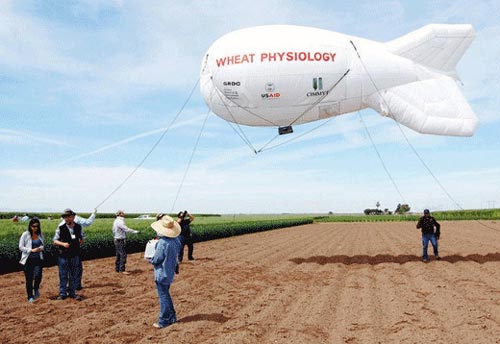 Visitors to the Centro Experimental de Norman E. Borlaug (CENEB) station, near Ciudad Obregon, Sonora, were lucky enough to witness the launch of CIMMYT’s first blimp on 13 March 2012. Made possible through generous support from the Sustainable Modernization of Traditional Agriculture (MasAgro) project, the 8-meter helium-filled balloon underpins the airborne remote-sensing “platform” of the CIMMYT wheat physiology group. It will help analyze the physiological properties of thousands of wheat lines being tested as part of the Mexican phenotyping platform (MEXPLAT).
Visitors to the Centro Experimental de Norman E. Borlaug (CENEB) station, near Ciudad Obregon, Sonora, were lucky enough to witness the launch of CIMMYT’s first blimp on 13 March 2012. Made possible through generous support from the Sustainable Modernization of Traditional Agriculture (MasAgro) project, the 8-meter helium-filled balloon underpins the airborne remote-sensing “platform” of the CIMMYT wheat physiology group. It will help analyze the physiological properties of thousands of wheat lines being tested as part of the Mexican phenotyping platform (MEXPLAT).
“The blimp enables us to take data from large areas that previously had to be covered on foot,” said Maria Tattaris, a remote sensing specialist from the UK who has been working as a CIMMYT Post-Doc since January. Floating up to 300 meters above the fields, it provides a tactical vantage point for a thermal infrared imager and multispectral camera mounted on its underside. With four handlers guiding the blimp using ropes tied to the head and tail, its devices will quickly capture images and readings for attributes such as canopy temperature, stomatal conductance, canopy water content, vegetation indices, and pigment indices—all without having to destructively sample plants. The data will reveal plant stress levels under varying environments, as well as estimates of canopy biomass, growth rates, and photosynthetic capacity. The blimp also allows single, large-area measurements, helping avoid temporal variation effects. Finally, mounting multiple cameras enables simultaneous readings on different plant canopy properties in a specific area.
Obregón’s soaring dirigible will soon share airspace with another remotesensing UAV—“unmanned aerial vehicle,” in fly-tech parlance: the AscTec Falcon 8, a camera-loaded, propellor-driven drone that looks like a dragonfly but takes high-resolution infrared and multispectral images.
The blimp launch caused a sensation among CENEB staff and 60 members of the Wheat Yield Consortium (WYC), hailing from 30 countries and currently in Obregón for the Consortium’s 2nd international workshop. According to Tattaris, data detected by the new bird’s-eye sensors should significantly further WYC work.